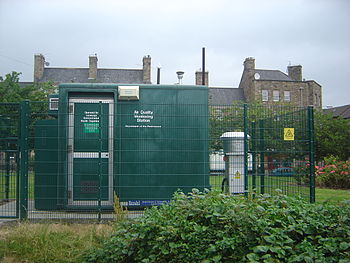 |
| An air quality measurement station in Edinburgh, Scotland (Photo credit: Wikipedia) |
Today we review research from Windsor, Ontario which compared the exposure to NO2 from an Ogawa personal exposure meter to daily exposure estimated from a fixed nearby measurement site, part of the National Air Pollution Surveillance (NAPS) network and in reference to emergency asthmatic cases. Results indicated that next to zero correlation between the two values from a sample of almost 1,000 measurements. The authors concluded that more attention must be paid to how exposure to pollution is estimated for risk estimates in epidemiological studies. This has significant implications for urban air quality network design as
well.
Key Quotes:
“In this study, our aim was to apply a Bayesian measurement error adjustment method that accommodates both a change in scale and measurement error variance to adjust risk estimates from fixed site values to those from personal exposures”
“In general, the weak correlation between short-term measures of personal and fixed-site NO2 observed in Windsor is consistent with existing evidence and suggests that caution is required when using fixed-site monitors to estimate short-term variations in personal NO2 exposures”
“Our findings suggest that risk estimates based on fixed-site NO2 concentrations may differ substantially from estimates based on personal exposures if the change in scale and/or measurement error is large. In practice, one must always keep the scale being used in mind when interpreting risk estimates and not assume that coefficients for ambient concentrations reflect risks at the personal level.”






No comments:
Post a Comment